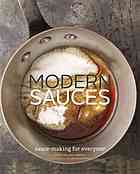Modern Sauces: More than 150 Recipes for Every Cook, Every Day. / Martha Holmberg. Published by Chronicle Books, San Francisco, California, 2012.

A sauce can make or break a dish, don’t you agree? Consider how pasta with a fresh tomato sauce would taste, as opposed to canned or bottled? Or a citrusy salad with homemade vinaigrette. Or green vegetables with Asian peanut sauce, a garlicky potato sauce or smoky red pepper sauce!
Holmberg’s Modern Sauces begin with the pairing of two ingredients for vinaigrette, resulting in a complex slightly thickened flavored liquid to pour over a salad. Right after that the sauces become much more involved, with many ingredients in herb, tomato, and vegetable sauces until you might as well be creating a main dish. This, says author Holmberg, is “the whole point”, the main reason to eat a creatively put-together meal. You can have your main ingredient for dinner, but without a sauce, you don’t have much to eat. If you had the ingredients to make your favorite group of sauces on hand, you needn’t want for something delicious to eat for dinner, or any time.
With 15 chapters plus index, you get “sauce essentials”, vinaigrettes and a whole collection of sauces made of herbs, vegetables, chiles, nuts, butter, cream, mayonnaise, custard, fruit, and chocolate to go with soups, salads, vegetable dishes, pastas, berries, cakes, puddings, and a variety of desserts. There are recipes for meat dishes included in this book; it is not essentially a vegetarian cookbook. However many recipes are meat-free and thus vegetarian, but you must read through the recipe to get your bearings.
Holmberg stipulates ingredients she is particular about, namely, butter, cream and crème fraiche, olive oil, nuts, parmigiano-reggiano cheese, and salt. Right away you know the sauces are European in taste, and you fear just might be difficult to make, but inspecting the Essentials chapter reveals that the author’s intent is to guide you to success. Each sauce recipe comes labeled with “storage” and “quick change” tips, ideas for swapping ingredients. And the very practical nature of the text immediately puts you at ease; with “three keys to recipe success”—this does seem simple enough. In each of the sauce types, you will learn the nature of the sauce, and how to steer clear of mistakes, before proceeding to make them in your kitchen.
Organize your complete sequence of sauces ahead of time, according to the kinds of dishes you normally prepare. Salads? then vinaigrettes, herb and vegetable sauces will enrich your plates and companion diners will love them, too. Sweet tooth? then caramel, cream, and chocolate sauces are in order. Vegetables? try butter, herb, cream, tomato. Fruit sauces are versatile, able to stretch from raw to cooked. There are luxurious sauces for when you have time and the inclination to make mayonnaise or hollandaise, gravy, sabayon and custard (although custards, etc. have not been veganized).
Sauces in this book are made from everyday ingredients and with careful attention to Holmberg’s details result in a gourmet experience in your kitchen. Organize, and do your prep—being organized can save the sauce, and the dish!
Follow


